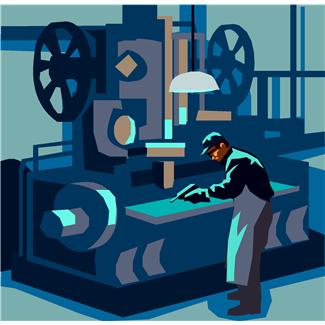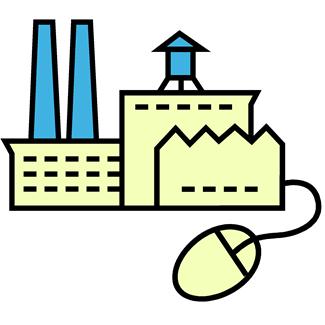![MC900433932[1]](http://simitarconsulting.com/wp-content/uploads/2013/10/MC9004339321.png) A wafer fab asked if I could tell them what level of maintenance-technician staffing would maximize profits in their epi area. Their technicians were the ones who repaired machines when they failed. Occasionally, all technicians would be busy when a machine failed, causing it to sit idle until a technician could get to it and conduct the repair. More technicians would cost more money but reduce this wait-for-technician time. Fewer technicians would save money but increase wait-for-technician time. Where was the profit-maximizing tradeoff? What was the profit-maximizing machine/technician ratio? Read more ›
A wafer fab asked if I could tell them what level of maintenance-technician staffing would maximize profits in their epi area. Their technicians were the ones who repaired machines when they failed. Occasionally, all technicians would be busy when a machine failed, causing it to sit idle until a technician could get to it and conduct the repair. More technicians would cost more money but reduce this wait-for-technician time. Fewer technicians would save money but increase wait-for-technician time. Where was the profit-maximizing tradeoff? What was the profit-maximizing machine/technician ratio? Read more ›
Sign up for free operations-improvement tips
- Archives are below, in chronological order
Case Study: Determining the Profit-Maximizing Machine/Technician Ratio
What Is “Reengineering”?
 How it Started
How it Started
Reengineering—sometimes called business process reengineering, or BPR—originated in a 1990 article in the Harvard Business Review by former MIT professor Michael Hammer, who followed up in 1993 with the seminal book Reengineering the Corporation.
The Core of Reengineering
The core of reengineering is a change in organizational structure, in which people who were formerly organized by function (“functional silos”) are instead organized by process or product. That is, all the people who need to work together in a process or product report to the same manager, instead of separate functional managers. There’s more to it than this, but this is the heart of reengineering. Read more ›
3 Rules for Getting the Most Out of Operations-Improvement Consultants
 Consultants can be a panacea to a firm, bringing in:
Consultants can be a panacea to a firm, bringing in:
• Fresh outside perspectives
• Expertise
• Unbridled firepower, since they’re not beholden to the daily production grind
But bringing in a consultant, if done wrongly, can be disruptive—and even destructive—to a firm. Read more ›
How “Overstaffing” at Bottleneck Machines Can Unleash Extra Capacity
![MP900382684[1]](http://simitarconsulting.com/wp-content/uploads/2013/05/MP9003826841-520x371.jpg) TDK felt that it needed another $5 million machine to open up a capacity bottleneck until Bob Kotcher’s computer-simulation analysis showed that additional operators could accomplish the same thing for dramatically less money. This was counterintuitive, since the operators already had significant slack capacity. Bob presented this paper at the 2001 Winter Simulation Conference—the premier international conference for system simulation: http://informs-sim.org/wsc01papers/157.PDF
TDK felt that it needed another $5 million machine to open up a capacity bottleneck until Bob Kotcher’s computer-simulation analysis showed that additional operators could accomplish the same thing for dramatically less money. This was counterintuitive, since the operators already had significant slack capacity. Bob presented this paper at the 2001 Winter Simulation Conference—the premier international conference for system simulation: http://informs-sim.org/wsc01papers/157.PDF
Restroom and Wet-Bench Equality, Now!
The simplest—and highest-profit-margin—modeling project that Simitar founder Bob Kotcher has ever done demonstrates the power of simulation modeling for operations improvement.
Celebrate your inner Seinfeld
At a restaurant one day, my inner Seinfeld came out (we all have one—come on).
Since the Americans With Disabilities Act was passed in 1990, many restaurants had to remodel their restrooms to make them wheelchair accessible. This often required them to remove internal partitions that comprised the stalls. With privacy gone, they put locks on the restroom doors and made each restroom single-user. Read more ›
Save Up to Millions of Dollars a Year in Capex: Use Dynamic Capacity Planning
![MP910216373[1]](http://simitarconsulting.com/wp-content/uploads/2013/05/MP9102163731.png) Dynamic capacity planning incorporates the randomness and variability of the real world. It shows you how to target your capital-equipment (capex) spending to attain throughput and cycle-time goals for millions of dollars less than with spreadsheets.
Dynamic capacity planning incorporates the randomness and variability of the real world. It shows you how to target your capital-equipment (capex) spending to attain throughput and cycle-time goals for millions of dollars less than with spreadsheets.
Dynamic capacity models account for the variability of the real world
In operations with variability, executives know that they cannot run them close to 100% loading because queue times become unacceptably high. They know to invest in surplus capacity—not to increase throughput, but to keep queue times in check.
But what is the optimal amount of surplus capacity to purchase, and exactly where? What is the optimal capital-equipment (capex) purchase plan? Read more ›
What Level of Capacity Planning is Right for My Facility?
 Capacity planning can range from literally back-of-the-envelope calculations to highly detailed computer models that require thousands of man-hours to build, interface with a company’s MES in real time, and even update and run themselves. Where on this spectrum is the right place for you? Read more ›
Capacity planning can range from literally back-of-the-envelope calculations to highly detailed computer models that require thousands of man-hours to build, interface with a company’s MES in real time, and even update and run themselves. Where on this spectrum is the right place for you? Read more ›
Use Real-Time Simulation to Preempt WIP Bubbles and Set Production Goals Each Shift
 Real-time simulation is a tool that takes into account the up-to-the-minute status of your factory and predicts what’s likely to happen in the coming hours, days, and weeks.
Real-time simulation is a tool that takes into account the up-to-the-minute status of your factory and predicts what’s likely to happen in the coming hours, days, and weeks.
Knowing this, you can preempt problems such as WIP bubbles. The result is:
- Higher throughput
- Better on-time delivery
- Reduced cycle time
- Reduction in problems/headaches/firefighting
It also enables you to set more realistic production goals for your managers each shift. Read more ›
How Do I Choose Between Lean, Six Sigma, Theory of Constraints (TOC), and other Operations-Improvement Approaches?
 Industrial Engineering is the optimization of systems of people and technology. This can be as narrow as optimizing performance of a single machine, or as broad as optimizing performance of an entire company. As with any field, over time, people have continually discovered better ways of doing things. At certain points, authors and consultants—for better or worse—have coined new buzzwords for the current state of the art. Over the last thirty years, some of these have been: Total Quality, JIT (Just-In-Time), World-Class Manufacturing, Lean, Reengineering, Six Sigma, TPS (Toyota Production System), and Theory of Constraints (TOC). These are all just other names for…
Industrial Engineering is the optimization of systems of people and technology. This can be as narrow as optimizing performance of a single machine, or as broad as optimizing performance of an entire company. As with any field, over time, people have continually discovered better ways of doing things. At certain points, authors and consultants—for better or worse—have coined new buzzwords for the current state of the art. Over the last thirty years, some of these have been: Total Quality, JIT (Just-In-Time), World-Class Manufacturing, Lean, Reengineering, Six Sigma, TPS (Toyota Production System), and Theory of Constraints (TOC). These are all just other names for…
The state of the art in industrial engineering
I can’t think of any aspect of the above philosophies that conflicts with any other. Each iteration is just what came before it, combined with new findings. So you don’t need to determine which to apply. A competent industrial engineer will know all of them, and make use of all of their tools as appropriate.
How to Improve Factory Performance via Computer-Simulation Modeling
 Overview of modeling
Overview of modeling
Unlike most other operations-improvement consultancies, Simitar is expert in computer-simulation modeling.
When operations are highly complex or variable, computer-simulation modeling can reveal huge opportunities for savings that spreadsheet models—and even experienced observers—overlook. That’s because simulation models take into account the variability present in real life. Simulation models also include a critical factor that spreadsheet models ignore: cycle time, and how it varies with load. Read more ›
Posted in Capacity planning, Computer-simulation modeling, Operations improvement




 Loading
Loading